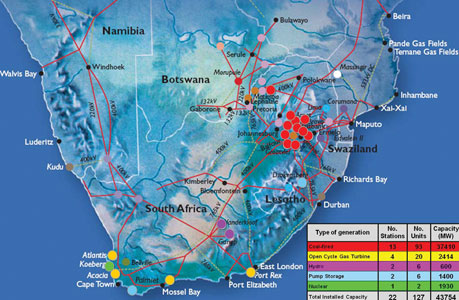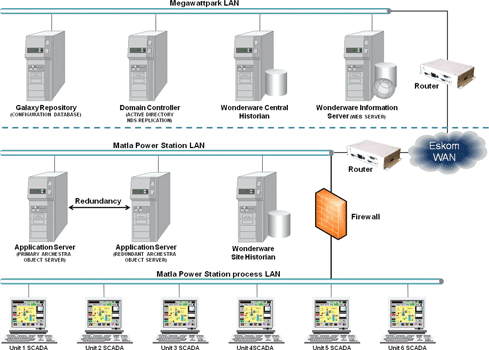
The utility is investing a great deal of energy, finance and technology into understanding the behaviour and status of its complex grid and generation facilities on a national level with an initiative that is known as the plant data system or PDS.
Plant information issues
“The drive for increased reliability and efficiency of operation requires better plant information in realtime,” says John Viljoen, corporate consultant for Generation Business Engineering at Eskom. “The plant condition is deteriorating due to ageing which prompts the need to get a better handle on condition monitoring information and since electricity supply must match the demand at all times, accurate production information is critical.”
Traditionally, process automation solutions provide operating information to help operators manage their plants more effectively but, according to Viljoen, this is only one aspect of the information spectrum necessary for Eskom to be more effective. “Engineers, for example need asset information for asset lifecycle management. It is not as if we lack the data, we have masses of it at plant level but useable information is not readily accessible.”

Information technology issues
While Eskom’s IT infrastructure focuses on improved business performance and efficiency, it is nevertheless a transactional environment not suited to the realtime world of plant production. “In so far as IT is concerned, plant control systems are black boxes that we do not understand,” says Vicki Naudé, senior advisor for Generation Information Management at Eskom. “Our integration and storage methods focus on transactional systems in a fragmented and outsourced IT infrastructure that is not suitable for the realtime plant environment. So the intention is to broaden the scope of IT to include plant information while providing for the necessary levels of security.”
This left Eskom with the challenge of managing the escalating complexity of merging its plant information world with its information technology environment.
Project objective
The PDS project goal is to make plant data openly accessible, in a standardised format, to every area of the business that can use it to improve the bottom line. In order to do this, plant data would have to be readily transformed into useful plant information in order to meet the specific information needs of those who need it.
It was hoped that the more effective use of plant information would ultimately result in more refined performance indicators, better optimisation of plant and better allocation of resources. Plant data could also be delivered to specialist engineers in order to improve incident response.
Project requirements
Any solution must meet the need for near realtime information to support both operational and business decisions while also addressing the issue of standardisation. “Each power station is unique and in the past, there had been no attempt at standardisation so that they all had different control and operational systems,” says Viljoen. “Since the natural tendency is for people to improve their information systems, we did not want a proliferation of different solutions with each power station implementing their own ideas. So, a primary requirement was standardisation that would eliminate duplication of engineering effort, interface development and solution deployment.”
Eskom would select a solution based on the least cost but that would provide the required functionality. “Such a requirement would indicate a centralised solution rather than the far more expensive alternative of multiple and diverse information systems,” adds Viljoen. “Another advantage of basing solution selection on cost is that one of the major cost components of such systems is licensing, which is based on tag volume. By purchasing half a million tags for the whole of Eskom, we spent significantly less than if each power station bought, say 50 000 tags of its own. So, insofar as we were concerned, buying technology that would meet these requirements was seen as establishing a platform which would enable the various parts of the business to improve their performance. In other words, we would install a business enabler.”
Solution selection
Eskom issued an open Request for Proposal to the market and the Wonderware solution was deemed to offer the best cost/functionality performance ratio. The ArchestrA framework was ideally suited to the rapid deployment of a standardised solution across all the power stations and web-based viewing enabled a cost effective method of managing a large number of simultaneous users. The combination of Wonderware System Platform, Wonderware Historian, InTouch (HMI/SCADA) and the Wonderware Information Server met all the specific requirements for realtime data management.
Eskom selected ArchestrA-certified system integrator Bytes Technology Group because of the company’s track record of implementing large and small PDS-like solutions on-time and in budget, its existing knowledge of Eskom solutions and its numerous awards for the successful implementation of integrated ArchestrA-based Wonderware solutions.
PDS project description
With the project goal of providing a standard platform for obtaining plant data via a single interface, Eskom structured the system as shown by the topology diagram in Figure 1 (only Matla Power Station shown). “While each power station has its own Historian, we replicate the information we need at head office in a central Historian so as to minimise WAN access,” says Naudé. “We also have a firewall between the business LAN and the process LAN for security purposes and to ensure that only the PDS has access to process data.”

Eskom spent a lot of time and effort to structure the data model so that it would conform to Eskom’s Generic Plant Breakdown Guide and the ISA-95 standard, an exercise which would soon prove to be extremely worthwhile. “Halfway through the project, Eskom changed its structure and we had already built our (System Platform/ArchestrA) galaxy,” says Naudé.
“Instead of a train smash, we were confronted with a simple drag-and-drop exercise before once again being on track. This could not have happened without a properly designed data model.”
The design of master templates for such plant items as furnaces also greatly reduced engineering time and facilitated deployment since only specific attributes needed be changed to cater for different furnace types.
The initial target for the PDS is 80 super users (ActiveFactory) and 500 web users. Since the generic training on the Wonderware components of the PDS would take approximately six weeks with the risk of users losing interest along the way, Wonderware Southern Africa structured a condensed three-day training course specific to the PDS.
Since it was deployed, the PDS has been of such value that users have wanted more and motivated for the expansion of this valuable information commodity. Although the PDS is only part of Eskom’s overall information strategy, it is nonetheless the realtime portion that provides decision makers a vital window into the realities of their power generation initiatives.
Realised benefits
* Realtime plant data is now a reality and available to anyone who can make best use of it.
* Standardisation has been achieved with its attendant reduction in engineering effort, rapid adaptability to changes and elimination of disparate information solutions.
* The approach taken towards the PDS project was definitely cost effective and proved the economies of scale that can be achieved with the right solution.
* The PDS project has significantly raised the visibility of the benefits that can be derived from open access to realtime and useful plant information.
* The project has fostered a closer relationship between plant and IT and the different needs of both disciplines.
* Numerous applications are now using the PDS data and all the information is available anywhere to any qualified person.
* PDS is a business enabler that improves the ability of people to conduct their business more effectively.
Conclusion
Eskom bears an awesome responsibility – the continuation of our way of life – while its ‘shop floor’ consists of nothing less than southern Africa. Eskom now has the tools to better understand and control its vast and complex power generation machine and to improve the quality of life of more than 50 million people.
For more information contact Deon van Aardt, Wonderware Southern Africa, 0861 WONDER, [email protected], www.wonderware.co.za

© Technews Publishing (Pty) Ltd | All Rights Reserved